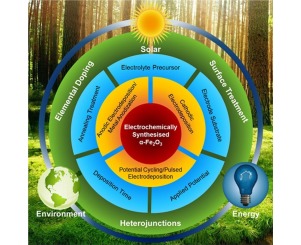Journal of Photochemistry and Photobiology C: Photochemistry Reviews ( IF 12.8 ) Pub Date : 2017-10-10 , DOI: 10.1016/j.jphotochemrev.2017.10.001 Yi Wen Phuan , Wee-Jun Ong , Meng Nan Chong , Joey D. Ocon

|
Hematite (α-Fe2O3) is found to be one of the most promising photoanode materials used for the application in photoelectrochemical (PEC) water splitting due to its narrow band gap energy of 2.1 eV, which is capable to harness approximately 40% of the incident solar light. This paper reviews the state-of-the-art progress of the electrochemically synthesized pristine hematite photoanodes for PEC water splitting. The fundamental principles and mechanisms of anodic electrodeposition, metal anodization, cathodic electrodeposition and potential cycling/pulsed electrodeposition are elucidated in detail. Besides, the influence of electrodeposition and annealing treatment conditions are systematically reviewed; for examples, electrolyte precursor composition, temperature and pH, electrode substrate, applied potential, deposition time as well as annealing temperature, duration and atmosphere. Furthermore, the surface and interfacial modifications of hematite-based nanostructured photoanodes, including elemental doping, surface treatment and heterojunctions are elaborated and appraised. This review paper is concluded with a summary and some future prospects on the challenges and research direction in this cutting-edge research hotspot. It is anticipated that the present review can act as a guiding blueprint and providing design principles to the scientists and engineers on the advancement of hematite photoanodes in PEC water splitting to resolve the current energy- and environmental-related concerns.
中文翻译:

电化学合成赤铁矿光阳极在光电化学水分解中的应用前景
赤铁矿(α-的Fe 2 ö 3)被发现是最有前途的光阳极材料之一,由于其2.1 eV的窄带隙能,能够利用约40%的入射太阳光,因此可用于光电化学(PEC)水分解。本文综述了电化学合成的原始赤铁矿光阳极用于PEC水分解的最新进展。详细阐述了阳极电沉积,金属阳极氧化,阴极电沉积和电势循环/脉冲电沉积的基本原理和机理。此外,系统地回顾了电沉积和退火处理条件的影响;例如,电解质前体的成分,温度和pH值,电极基材,施加的电势,沉积时间以及退火温度,持续时间和气氛。此外,详细阐述了基于赤铁矿的纳米结构光阳极的表面和界面改性,包括元素掺杂,表面处理和异质结。这篇综述文章总结了这一前沿研究热点所面临的挑战和研究方向,并进行了展望。可以预期,本综述可以作为指导性蓝图,并为科学家和工程师提供设计原则,以解决PEC水分解中赤铁矿光阳极的发展,以解决当前与能源和环境相关的问题。这篇综述文章总结了这一前沿研究热点所面临的挑战和研究方向,并进行了展望。可以预期,本综述可以作为指导性蓝图,并为科学家和工程师提供设计原则,以解决PEC水分解中赤铁矿光阳极的发展,以解决当前与能源和环境相关的问题。这篇综述文章总结了这一前沿研究热点所面临的挑战和研究方向,并进行了展望。可以预期,本综述可以作为指导性蓝图,并为科学家和工程师提供设计原则,以解决PEC水分解中赤铁矿光阳极的发展,以解决当前与能源和环境相关的问题。











































 京公网安备 11010802027423号
京公网安备 11010802027423号